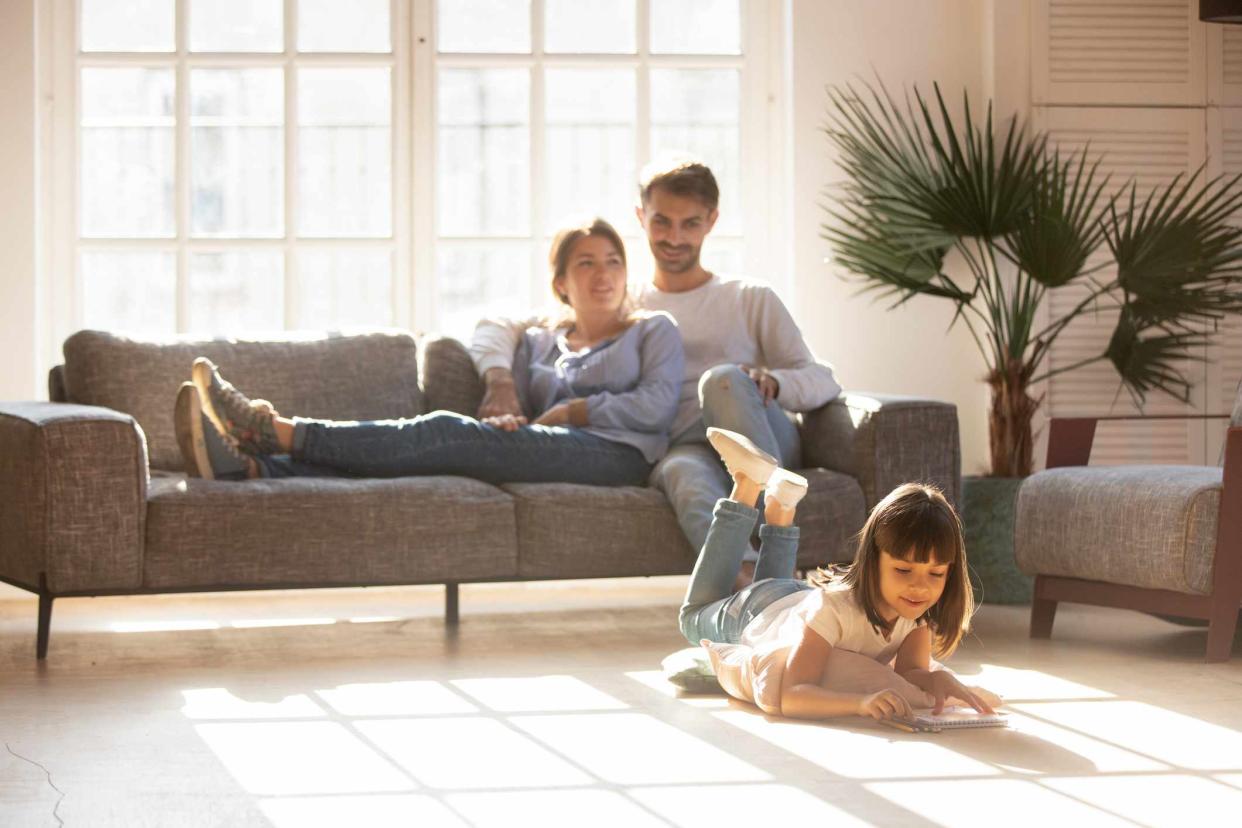How to Create a Sensory Room for Your Autistic Child

Fizkes / Getty Images
Fact checked by Marley HallMedically reviewed by Huma Sheikh, MD
Autistic children and adults often respond positively to certain types of sensory input. Some, for example, find weighted blankets and tight clothing calming, while others are able to focus better when engaged in physical activity. Sensory rooms provide a range of calming and stimulating sensory inputs that can be designed for a group or for a particular individual's needs.
While it's possible to spend a great deal of money to provide your child with a sensory space that addresses their needs, it's also quite possible to do the same thing on a very limited budget. The key is to pinpoint the sensory experiences that work best for your child, and then find cost-effective, appropriate products and techniques to provide those experiences.
This article explains what sensory rooms are designed to do, and some of the specific sensory experiences and tools that may benefit autistic kids.

Sensory Challenges and Autism
In 2013, the diagnostic criteria for autism were changed to include "hyper- or hypo-reactivity" to sensory input or unusual interest in sensory aspects of the environment. These heightened or lower responses to aspects can include:
Pain or discomfort
Temperature
Specific sounds
Textures
Excessive focus on smells
Intense need to touch objects
Visual fascination with lights or movement
The vast majority of autistic people are either attracted to or are hyper-reactive to sensory input. Many people are both over-reactive and under-reactive to sensory input, depending on the type of input and the context in which it is experienced.
Yet sensory experiences can also help autistic individuals to build their sense of balance, improve core strength, and manage sensory "assaults" such as loud music, fluorescent lights, and strong smells.
Takeaway
Both anecdotal evidence and research suggest that it is possible to use sensory inputs as a tool to help autistic people "self-regulate," or manage their own anxiety, stress, and sensory overloads.
The reality is that the research, while positive, is not absolutely conclusive. Yes, sensory therapy and sensory rooms seem to be helpful, but as one review of studies states, "Although small randomized controlled trials resulted in positive effects for sensory integration therapies, additional rigorous trials using manualized protocols for sensory integration therapy are needed to evaluate effects for children with autism spectrum disorders and sensory processing problems."
Related: About Sensory Integration Therapy
Despite gaps in the research, however, sensory interventions are increasingly popular for autistic kids. The reasons are obvious: children enjoy the interventions and many feel calmer and happier after sensory experiences. In addition, sensory rooms and sensory therapies have no dangerous side effects, can improve physical health, and are relatively low cost.
Sensory Integration Therapists
Sensory integration therapists, most of whom are occupational therapists with additional training, use a variety of tools to provide appropriate sensory experiences for individual clients. For example, a weighted vest can help an autistic child to feel more focused and centered, making it easier to participate in classroom activities.
Related: What Is Occupational Therapy?
What Are Sensory Rooms?
Sensory rooms are spaces dedicated to sensory experiences designed specifically to help autistic people to feel calm, supported, and focused. Sensory rooms are most often found in clinical settings such as occupational therapists' offices, autism clinics, and residential settings for autistic people with high support needs.
Some are very elaborate; Snoezelen Multisensory Environments, for example, are high-tech spaces intended not only for autistic people but also for people with dementia and other disorders.
Takeaway
High-tech and expensive sensory resources, while they can be effective, are not necessarily the best or only way to furnish a sensory room. In fact, products sold as "sensory" toys, swings, or furnishings are often just marked-up versions of much less expensive items available at any big box store.
Related: Autism Traits and When to See a Healthcare Provider
Questions to Ask Yourself Beforehand
If your autistic child or adult family member feels calmer and more focused in certain types of settings, a sensory room (or space) may be an important addition to your home. It can provide a sanctuary for escaping sensory overload, a reward for good behavior, a tool for self-calming, or even a therapeutic space for building skills.
Before you get started, it's important to consider these questions.
Where will your sensory room or space be located? If all you have is a corner of the living room, you'll obviously have to limit the number of items you purchase; you may also want to find a way to section off that portion of the room with a screen, popup tent, or other demarcation. Even a toy tent is large enough to provide a sensory sanctuary for your child.
What is your budget? If you have a few thousand dollars to spare, you have a lot of options. Even if you have only $100, though, you can get the job done.
What is the purpose of the room? Is it simply intended to be a sanctuary for your child, where he can go whenever he feels the urge? Or are you planning to use it for therapy, teaching, or other activities?
What sensory experiences will help your child? To answer this question, you may want to work with an occupational therapist who knows your child well. Some children do best with very active, physical experiences while others prefer to cocoon. Some are attracted to music while others find it irritating.
Takeaway
Your child's reactions to various sensory stimuli, along with their particular needs and challenges, will dictate the choices you make.
Selecting Items for Your Sensory Room
You'll be selecting items from different categories to include in your sensory room, choosing the specific items that fit your space and your budget and which (most importantly) appeal to your child. Each relates to a different aspect of your child's sensory experiences.
Vestibular (Related to Balance)
Swings are almost always incorporated in sensory spaces and therapies because they are soothing and repetitive, create a sense of being cocooned, and help to build core strength and provide vestibular input.
You can choose an expensive therapeutic swing that is hung from the ceiling, but you can provide a similar experience with a less expensive hammock, glider rocker, or rocking horse.
Proprioceptive (Orientation of the Body in Space)
Some autistic kids feel disconnected from their bodies and crave physical sensations to center themselves. Your body's sense of orientation is called proprioception.
Weighted vests and blankets can help with this, as can mini-trampolines, squeeze toys, and exercise balls. You can also provide pop-up tubes or simply roll your child in a blanket to create a "burrito."
To save money, avoid any item labeled "therapeutic." An ordinary exercise ball is just fine.
Related: An Overview of Proprioception
Visual
Autistic people are often visual learners, and visual input can be quite overwhelming. Fluorescent lights are notoriously problematic, but so too are halogen lights, flashing lights, etc.
Keep lights incandescent and relatively dim in your sensory room, and consider providing your child with mild visual stimulation in the form of low wattage pastel-colored lights, lava lamps, bubble columns, water fountains, or light projectors.
Again, for cost savings, avoid anything marked "therapeutic" or "sensory." Many of these items are even available at flea markets and yard sales.
Aural
For some autistic people, soothing sounds are a wonderful tool for relaxing. Consider providing your space with auditory resources. Options include CDs, white noise machines, chimes, or nature sounds. Use a headset if the noise is annoying to others in the household.
Olfactory
Many autistic people are unusually responsive to smells. Strong smells can be very off-putting; being forced to interact, for example, with farm animals can be upsetting.
By the same token, however, some smells can be relaxing and calming. You may want to experiment with aromatherapy to determine if it's helpful to your child.
Using Your Sensory Space
Once you've set up your sensory space, you'll find numerous ways to use it. For example:
Join your child in the space and play together as a way to build your relationship with one another while enhancing your child's social-communication skills.
Teach your child to use the space as a sanctuary where they can calm down if feeling agitated or anxious.
Offer time in the space as a reward for doing a good job on a less-preferred activity such as trying new foods.
Consult with your child's therapists about ideas for sensory experiences or resources that can help your child learn self-calming strategies.
Summary
Sensory rooms are risk-free, fun, and have the potential to make a positive difference in your child's life. Before diving in, however, it's important to know what will work best for your individual child.
First do the research on various skills and sensory integration benefits, and then consider the space you'll be using for a sensory room. It will help you decide how to invest your resources in the right tools and toys. Don't hesitate to ask your child's therapists for ideas.
Beware of products that are marked up to take advantage of eager parents who are willing to pay "whatever it takes" to help their child. You can provide a good-quality sensory room on any budget.

